Tradition and Innovation
 The photo is of the first iteration of the interpretation center of the Kala Raksha Museum. The idea was to portray the traditional context of embroidery for visitors. I engaged artisans to create replicas of pieces in the collection, a prelude to learning to innovate on traditions. I also engaged the late Hariyaben Bhanani, suf embroidery artist, in creating the display to ensure authenticity. A photo of a wedding in her community adds context.
The photo is of the first iteration of the interpretation center of the Kala Raksha Museum. The idea was to portray the traditional context of embroidery for visitors. I engaged artisans to create replicas of pieces in the collection, a prelude to learning to innovate on traditions. I also engaged the late Hariyaben Bhanani, suf embroidery artist, in creating the display to ensure authenticity. A photo of a wedding in her community adds context.
When we were dressing mannequins for the display, Hariyaben asked me what to put for the bride’s skirt?
“Traditional,” I said.
“Which tradition?” she asked.
A profound question. She understood living tradition.
As Santhosh Sakhinala has said, concepts inherent in creating traditional craft did not need to be distinguished. ‘Upcycling’ and ‘design’ were embedded in making. Similarly, innovation was essential to a living tradition. Artisans adapted their work organically, ensuring its relevance for the evolving lives of intimately known users, using known materials and processes. For male textile artisans of Kutch, who created as livelihood exchange, innovation played a relatively minor role. The textiles that they traditionally made were identity markers; clients did not want to differ significantly from community members. For women who traditionally embroidered for themselves, creative innovation was an intrinsic value. They strived to innovate while retaining an essential identity that they as a community defined.
When craft is one’s life, innovation is play, the joy in creating. Tagore, in his critique ‘The Cult of the Charkha,’ emphasized that it is the minds of individuals that prevent them from becoming bullocks going round a narrow range of habit; thus man has looked down on mechanically repetitive work.
Innovation distinguishes hand craft from industry. It is also a key means of maintaining relevance. Variation is driven by the consumer; thus artisans must directly access markets.
Tradition and innovation are relative and perhaps irrelevant terms, as Hariyaben wisely implied. When today we name and segregate these terms, it creates occasions for judgement and raises an uneasy question: Who gets to arbitrate?
As Sarah Sockbeson, a Penobscot artist from Maine said, “It should be up to the artist to determine our art. It’s up to the market to support it.”



